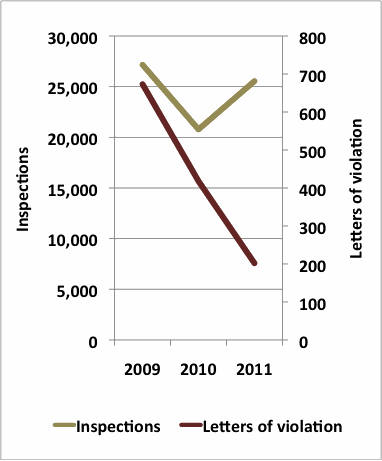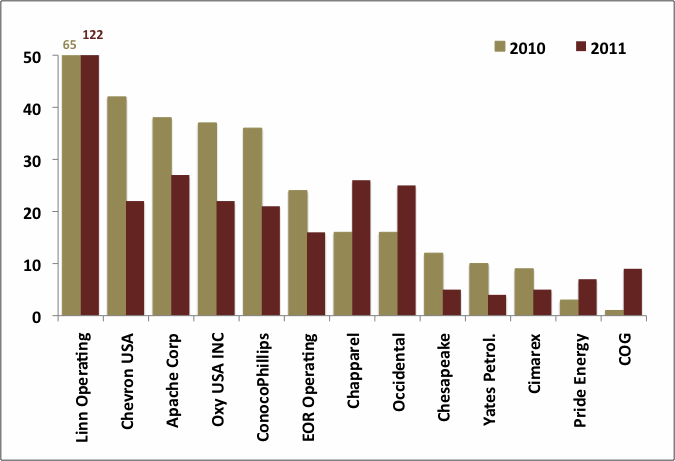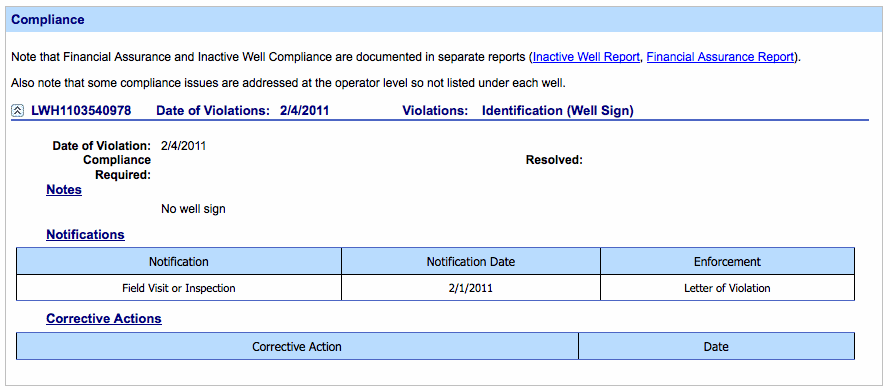NM Oil & Gas Enforcement - Violations
|
Box 1: OCD Violations data |
|
How does OCD track violations? OCD maintains a non-public Compliance Database that includes information on wells with violations, dates of violations, OCD response (non-compliance letter, phone call, email, etc.), and date that compliance was achieved. What is public? In New Mexico the only violations-related information readily available to the public is on a well-by-well basis via the OCD Electronic Permitting System (EPS). It would be impossible for a person to to get the big picture -- compile statistics on violations by going through tens of thousands of individual well files. How can the public tell if a violation has occurred? In most cases, scanned copies of Letters of Violation and other letters issued to well operators for less serious violations can be viewed in the EPS well file documents. But letters are not issued for every violation. Also, not all letters cite the rule(s) that have been violated. What is the difference between and Letter of Violation (LOV) and other types of letters? When inspectors find what they consider violations, official Letters of Violation (LOVs) may be set to operators. Less serious violations, may not receive an LOV, but may still send a (lesser) noncompliance notification letter to the operator. Or OCD may simply phone or email the operator. Information on LOVs found in EPS well files can be misleading. Under the Compliance tab of the well file, both the Notification and Enforcement boxes may say that a “Letter of Violation” was sent. However, the only time OCD considers that an official Letter of Violation was issued is if the Notification box shows a Letter of Violation. If the Notification box contains anything other than Letter of Violation, even if the Enforcement box shows Letter of Violation, then an official LOV was not issued. (A non-compliance letter may have been sent, but these letters are not treated the same as LOVs, and are not included in LOV statistics). See the two examples below.
LOV issued
No LOV issued Making matters worse is that all letters sent to an operator have the title LETTER OF VIOLATION, regardless of whether it was an actual LOV, or simply a letter sent to inform operators of non-compliance. According to OCD, this is because the Risk-Based Data Management System used by its inspectors automatically formats letters, and therefore all of them include the title LETTER OF VIOLATION. Although aware of this glitch, OCD has not allocated staff time to fix it.[1] |
Violations data are lacking
Violations data is hard to get in New Mexico (See Box 1). The state Oil Conservation Division (OCD) does maintain a violations database, but it isn't public. Nor are violation statistics published on the OCD web site.
OCD should make oil and gas violations data easily accessible to the public.
OCD should develop an on-line, publicly accessible system that allows both OCD staff and the public to track an operator’s record of compliance and ensure that violations have been corrected. The database should include information on violations by:
- well sites,
- operator name,
- the rules violated,
- the OCD response (e.g., date and type of enforcement actions),
- the date compliance achieved,
- and a link to other OCD well data.
All violations, regardless of whether or not an LOV was issued, should be recorded and tracked by OCD. These statistics should be compiled and reported on a monthly and annual basis on the “Statistics” page of the OCD web site and be available for bulk download.
Are New Mexico violations on the decline?
Since statistics on oil and gas violations in New Mexico are not available, we attempted to gauge violations by looking at the number of "Letters of Violation" (LOV) issued by OCD in the past three years.[2]
LOVs are sent to notify operators that they are in violation of OCD rule(s), and to inform operators of a date by which they must resolve violation(s). As shown in the chart below, the number of LOVs sent to operators in 2009, 2010 and 2011. The OCD data show a sharp decrease in the number of LOVs sent over the past few years. Less than one-third of the number of LOVs issued in 2009 were sent in 2011 (673 vs. 202). This does not necessarily mean that violations have declined. According to OCD, statistics on LOVs do not reflect the total number of violations per year,[3] as each letter may contain multiple violations, and LOVs are typically only sent to operators when there are serious violations.
Furthermore, as described in New Mexico Penalties and Sanctions, OCD inspectors have a great deal of discretion in how they deal with violations. So statistics on LOVs are an unreliable measure of violations and non-compliance.
NM Letters of Violation (LOV)

Click chart for larger version
It’s not clear why there has been such a dramatic decrease in the number of LOVs. In some states, there is a relationship between the number of inspections and the number of violations (more inspections lead to the discovery of more violations). But this does not appear to be the case in New Mexico.
As discussed in the section on New Mexico Penalties and Sanctions, OCD is severely hamstrung in its ability to pursue enforcement actions against operators that violate OCD rules. If operators refuse to comply with the requirements in LOVs, it is unlikely that OCD will ever pursue civil penalty actions because the expense of these undertakings is more than the meager penalties that can be collected under the current rules. So, it is possible that the agency may be expending fewer resources on recording violations and issuing LOVs, and instead focusing efforts on achieving compliance through alternative means.
One such alternative approach appears to be helping to decrease non-compliance by new operators. Over the past few years the state has been educating new operators on particular types of violations. In 2009, the OCD enforcement team identified ten common compliance problems [4] and implemented a program to review rule requirements with each new well operator. Operators receive an orientation letter in which the common compliance problems are mentioned, and the operators are required to sign and return a letter saying that they have read and understood the requirements of the particular rules. According to OCD, compliance by new operators has improved [5] since the implementation of the orientation letter. (View a copy of the orientation letter )
Select operators notified of non-compliance

Click chart for larger version
Compliance still a problem
Even if new operator compliance is improving OCD data suggest that compliance among existing operators is still a problem. Many of the same operators are receiving high numbers of non-compliance letters from one year to the next. The following three charts use data from OCD Compliance Summaries.[6] The first chart illustrates how some companies clearly have a problem with compliance.[7]
How quickly operators resolve violations is another important factor to consider when evaluating the effectiveness of an enforcement program. This chart shows that certain companies have a difficult time coming into compliance. (Chart does not include all operators with unresolved violations) As of February, 2012 the operators in the chart had still not resolved the problems that led to LOVs and other letters of non-compliance in 2010 and 2011.
# unresolved violations by operator

Click chart for larger version
OCD Compliance Summary data show that as of early 2012 compliance had been achieved in 311 (39%) of the 797 incidents that resulted in letters of non-compliance in 2010, and compliance had been achieved in 170 of the 453 cases in 2011 (38% compliance).
With respect to the more serious violations (those that warranted LOVs), Earthworks’ analysis of OCD data showed slightly higher rates of compliance. In 2010, 414 LOVS were sent to operators, and as of early, 2012 compliance had been achieved for 220 (53%) of the cases. In 2011, 203 LOVs were sent, and compliance had been achieved for 101 (50%) of the cases. These rates may be higher, but when only half of the serious problems are resolved within a year or two, it is clear that there is a significant problem with compliance.
For more information:
- Earthworks: Enforcement Report - OCD: Public should not have confidence that oil and gas development is occurring responsibly in the state of New Mexico. Report
- Earthworks: New Mexico Oil & Gas Enforcement. Web page
- Earthworks: New Mexico Oil & Gas Enforcement - Inspections. Web page
- Earthworks: New Mexico Oil & Gas Enforcement - Violations. Web page
- Earthworks: New Mexico Oil & Gas Enforcement - Enforcement Actions. Web page
- Earthworks: New Mexico Oil & Gas Enforcement - the Public's Role. Web page
Endnotes
1 For example, this Letter of Violation and Shut-In Directive for Apache’s East Blinebry Drinkard Unit #003 well did not mention which rule(s) had been violated, while this Letter of Violation and Shut-In Directive for Apache’s North Monument G/SA Unit #003 well did list a rule violation.
2 Personal communication between Lisa Sumi, Earthworks and New Mexico Oil Conservation Division Enforcement and Compliance Manager, Daniel Sanchez, OCD attorney, Sonny Swazo, and New Mexico Environment Department & Energy, Minerals & Natural Resources Department Communications officer, Jim Winchester. March 26, 2012.
3 Upon request, OCD provided Earthworks with statistics on the number of Letters of Violation sent to operators in 2009, 2010 and 2011. Information request made to Jim Winchester, New Mexico Environment Department & Energy, Minerals & Natural Resources Department from Lisa Sumi, Earthworks. Data received Feb. 27, 2012.
4 New Mexico Energy, Minerals and Natural Resources Departmental Annual Report for 2009. Page 53.
5 Personal communication between Lisa Sumi, Earthworks and New Mexico Oil Conservation Division Enforcement and Compliance Manager, Daniel Sanchez, OCD attorney, Sonny Swazo, and New Mexico Environment Department & Energy, Minerals & Natural Resources Department Communications officer, Jim Winchester. March 26, 2012.
6 Compliance Summaries received as a result of an information request to Jim Winchester, New Mexico Environment Department & Energy, Minerals & Natural Resources Department from Lisa Sumi, Earthworks. Data received March 5, 2012.
7 The Compliance Summaries provided by OCD included information on “Date compliance achieved.” According to OCD, however, the information on whether or not compliance has been achieved may not be entirely accurate because inspectors may not have entered the data into the system, operators may have corrected problems but not notified OCD, or inspectors may not have carried out a follow-up inspection to ensure that violations had been corrected. It may not be entirely accurate, but it is the best information available at this time. Compliance Summaries received as a result of an information request to Jim Winchester, New Mexico Environment Department & Energy, Minerals & Natural Resources Department from Lisa Sumi, Earthworks. Data received March 5, 2012.
8 It was not possible, due to time constraints, to summarize data for all operators, so the following charts contains a selection of operators receiving enforcement letters (LOVs, FVI or LET in the compliance summaries) in 2010 and 2011.
Tagged with: violations, regulation, new mexico, fracking, enforcement, drilling


Follow Earthworks